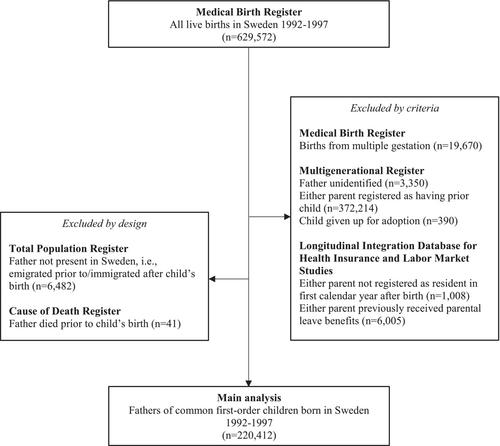Alcohol-related morbidity and mortality by fathers' parental leave: A quasi-experimental study in Sweden
Abstract
Background and Aims
Fathers' parental leave has been associated with decreased risks of alcohol-related hospitalizations and mortality. Whether this is attributable to the health protections of parental leave itself (through stress reduction or behavioral changes) or to selection into leave uptake remains unclear, given that fathers are more likely to use leave if they are in better health. Using the quasi-experimental variation of a reform incentivizing fathers' leave uptake (the 1995 Father's quota reform), this study aimed to assess whether fathers' parental leave influences alcohol-related morbidity and mortality.
Design
Quasi-experimental interrupted time series and instrumental variable analyses.
Setting
Sweden.
Participants
Fathers of singleton children born from January 1992 to December 1997 (n = 220 412).
Measurements
Exposure was indicated by the child's birthdate before or after the reform and used to instrument fathers' 2- and 8-year parental leave uptake. Outcomes included fathers' hospitalization rates for acute alcohol-related (intoxication; mental and behavioral disorders) and chronic alcohol-related diagnoses (cardiovascular, stomach and other diseases; liver diseases), as well as alcohol-related mortality, up to 2, 8 and 18 years after the first child's birthdate.
Findings
In interrupted time series analyses, fathers of children born after the reform exhibited immediate decreases in alcohol-related hospitalization rates up to 2 (incidence rate ratio [IRR] = 0.66, 95% confidence interval [CI] = 0.51–0.87), 8 (IRR = 0.74, 95% CI = 0.57–0.96) and 18 years after birth (IRR = 0.72, 95% CI = 0.54–0.96), particularly in acute alcohol-related hospitalization rates, compared with those with children born before. No changes were found for alcohol-related mortality. Instrumental variable results suggest that alcohol-related hospitalization decreases were driven by fathers' parental leave uptake (e.g. 2-year hospitalizations: IRR = 0.16, 95% CI = 0.03–0.84).
Conclusions
In Sweden, a father's parental leave eligibility and uptake may protect against alcohol-related morbidity.


 求助内容:
求助内容: 应助结果提醒方式:
应助结果提醒方式:


